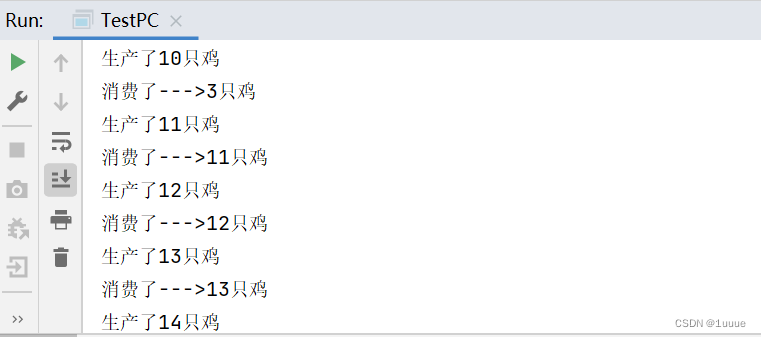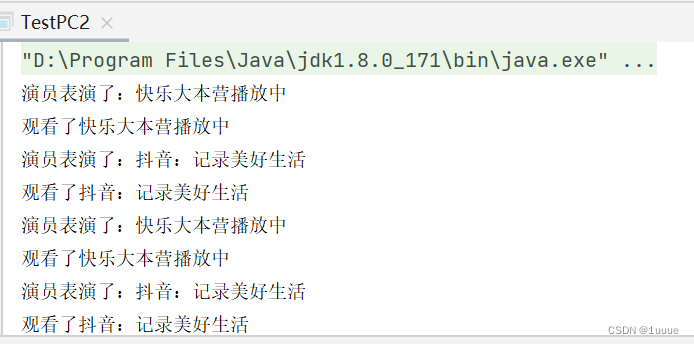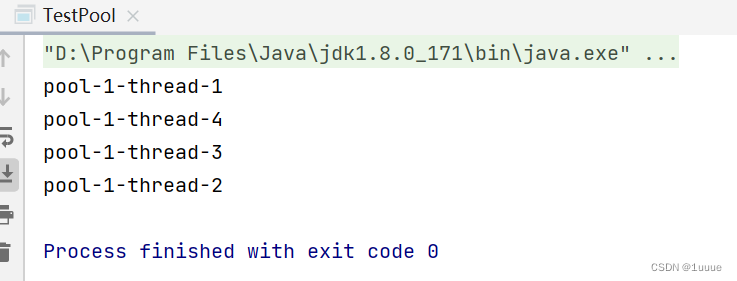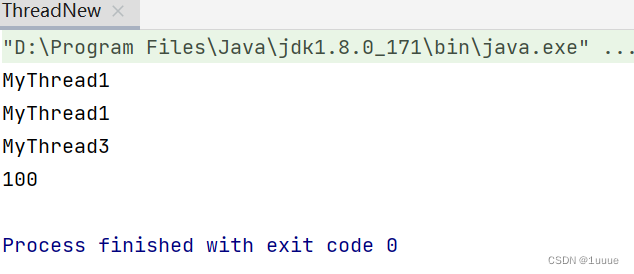目录
一、线程协作
应用场景:生产者消费者问题
1)假设仓库中只能存放一件产品,生产者将生产出来的产品放入仓库,消费者将仓库中的产品取走消费
2)如果仓库中没有产品,则生产者将产品放入仓库,否则停止生产并等待,直到仓库中的产品被消费者取走为止
3)如果仓库中放有产品,则消费者可以将产品取走消费,否则停止消费并等待,直到仓库中再次放入产品为止
分析:
这是一个线程同步问题,生产者和消费者共享同一个资源,并且生产者和消费者之间相互依赖,互为条件
1)对于生产者,没有生产产品之前,要通知消费者等待,而生产了产品之后,又需要马上通知消费者消费
2)对于消费者,在消费之后,需要通知生产者已经结束消费,需要生产新的产品以供消费
3)在生产者消费者问题中,仅有synchronized是不够的
synchronized可组织并发并更新同一个共享资源,实现了同步
synchronized不能用来实现不同线程之间的消息传递(通信)
Java提供了几个方法解决线程之间的通信问题
| 方法名 | 作用 |
|---|---|
| wait() | 表示线程一直在等待,直到其他线程通知,与sleep不同,会释放锁 |
| wait(long timeout) | 指定等待的毫秒数 |
| notify() | 唤醒一个处于等待状态的线程 |
| notifyAll() | 唤醒同一个对象上所有调用wait()方法的线程,优先级别高的线程优先调度 |
注意:均是Object类的方法,都只能在同步方法或者同步代码块中使用,否则会抛出异常lllegalMonitorStateException
常用解决办法1:
并发协作模型 ”生产者/消费者问题“ --> 管程法
1)生产者:负责生产数据的模块(可能是方法,对象,线程,进程)
2)消费者:负责处理数据的模块(可能是方法,对象,线程,进程)
3)缓冲区:消费者不能直接使用生产者的数据,他们之间有个缓冲区
生产者将生产好的数据放入缓冲区,消费者从缓冲区拿出数据
常用解决办法2:
并发协作模型 ”生产者/消费者问题“ ---> 信号灯法
即设置标志位
二、管程法
利用缓冲区(管程法)解决生产者-消费者问题
所需类:生产者、消费者、缓冲区、产品
public class TestPC {
public static void main(String[] args) {
SynContainer container = new SynContainer();
new Productor(container).start();
new Consumer(container).start();
}
}
//生产者
class Productor extends Thread{
SynContainer container;
public Productor(SynContainer container){
this.container=container;
}
//生产
@Override
public void run() {
for (int i = 0; i < 100; i++) {
container.push(new Chicken(i));
System.out.println("生产了"+i+"只鸡");
}
}
}
//消费者
class Consumer extends Thread{
SynContainer container;
public Consumer(SynContainer container){
this.container=container;
}
//消费
@Override
public void run() {
for (int i = 0; i < 100; i++) {
System.out.println("消费了--->"+container.pop().id+"只鸡");
}
}
}
//产品
class Chicken{
int id;//产品编号
public Chicken(int id){
this.id=id;
}
}
//缓冲区
class SynContainer{
//需要一个容器大小
Chicken[] chickens=new Chicken[10];
//容器计数器
int count=0;
//生产者放入产品
public synchronized void push(Chicken chicken){
//如果容器满了,就需要等待消费者消费
if(count==chickens.length){
//通知消费者消费,生产者等待
try {
this.wait();
} catch (InterruptedException e) {
e.printStackTrace();
}
}
//如果没有满,就需要丢入产品
chickens[count]=chicken;
count++;
//可以通知消费者消费
this.notifyAll();
}
//消费者消费产品
public synchronized Chicken pop(){
//判断是否能消费
if(count==0){
//等待生产者生产,消费者等待
try {
this.wait();
} catch (InterruptedException e) {
e.printStackTrace();
}
}
//如果可以消费
count--;
Chicken chicken=chickens[count];
//吃完了,通知生产者生产
this.notifyAll();
return chicken;
}
}
运行结果:

三、信号灯法
利用标志位解决生产者-消费者问题
此处演员和观众的关系可理解为:录播
public class TestPC2 {
public static void main(String[] args) {
TV tv = new TV();
new Player(tv).start();
new Watcher(tv).start();
}
}
//生产者--演员
class Player extends Thread{
TV tv;
public Player(TV tv){
this.tv=tv;
}
@Override
public void run() {
for (int i = 0; i < 20; i++) {
if(i%2==0){
this.tv.play("快乐大本营播放中");
}else{
this.tv.play("抖音:记录美好生活");
}
}
}
}
//消费者--观众
class Watcher extends Thread{
TV tv;
public Watcher(TV tv){
this.tv=tv;
}
@Override
public void run() {
for (int i = 0; i < 20; i++) {
tv.watch();
}
}
}
//产品--节目
class TV{
//演员表演,观众等待
//观众观看,演员等待
String voice;//表演的节目
boolean flag=true;
//表演
public synchronized void play(String voice){
if(!flag){
try {
this.wait();
} catch (InterruptedException e) {
e.printStackTrace();
}
}
System.out.println("演员表演了:"+voice);
//通知观众观看
this.notifyAll();//通知唤醒
this.voice=voice;
this.flag=!this.flag;//取反
}
//观看
public synchronized void watch(){
if(flag){
try {
this.wait();
} catch (InterruptedException e) {
e.printStackTrace();
}
}
System.out.println("观看了"+voice);
//通知演员表演
this.notifyAll();
this.flag=!this.flag;//取反
}
}运行结果:

四、线程池
1)背景:经常被创建和销毁、使用量特别大的资源,比如并发情况下,对性能影响很大
2)思路:提前创建好多个线程,放入线程池中,使用时直接获取,使用完放回池中。可以避免频繁创建销毁、实现重复利用。类似生活中的公共交通工具。
3)好处:
a.提高响应速度(减少了创建新线程的时间)
b.降低资源消耗(重复利用线程池中线程,不需要每次都创建)
c.便于线程管理
I.corePoolSize:核心池的大小
II.maximumPoolSize:最大线程数
III.keepAliveTime:线程没有任务时最多保持多长时间会终止
4)JDK5.0起提供了线程池相关API:ExecutorService和Executors
5)ExecutorService:真正的线程池接口。常见子类ThreadPoolExcutor
a.void execute(Runnable command):执行任务/命令,没有返回值,一般用来执行Runnable
b.<T>Future<T> submit(Callable<T> task):执行任务,有返回值,一般用来执行Callable
c.void shutdown():关闭线程池
6)Excutors:工具类、线程池的工厂类,用于创建并返回不同类型的线程池
案例:测试线程池
public class TestPool {
public static void main(String[] args) {
//1.创建服务,创建线程池
//newFixedThreadPool 参数为线程池大小
ExecutorService service= Executors.newFixedThreadPool(10);
//执行Runnable接口的实现类
service.execute(new MyThread());
service.execute(new MyThread());
service.execute(new MyThread());
service.execute(new MyThread());
//2.关闭连接
service.shutdown();
}
}
class MyThread implements Runnable{
@Override
public void run() {
System.out.println(Thread.currentThread().getName());
}
}运行结果:

五、总结
回顾线程的创建
public class ThreadNew {
public static void main(String[] args) {
//Thread
new MyThread1().start();
//Runnable
new Thread(new MyThread2()).start();
//Callable
FutureTask<Integer> futureTask = new FutureTask<Integer>(new MyThread3());
new Thread(futureTask).start();
try {
Integer integer = futureTask.get();
System.out.println(integer);
} catch (InterruptedException e) {
e.printStackTrace();
} catch (ExecutionException e) {
e.printStackTrace();
}
}
}
//1.继承Thread类
class MyThread1 extends Thread{
@Override
public void run() {
System.out.println("MyThread1");
}
}
//2.实现Runnable接口
class MyThread2 implements Runnable{
@Override
public void run() {
System.out.println("MyThread1");
}
}
//3.实现Callable接口
class MyThread3 implements Callable<Integer>{
@Override
public Integer call() throws Exception {
System.out.println("MyThread3");
return 100;
}
}
运行结果:
